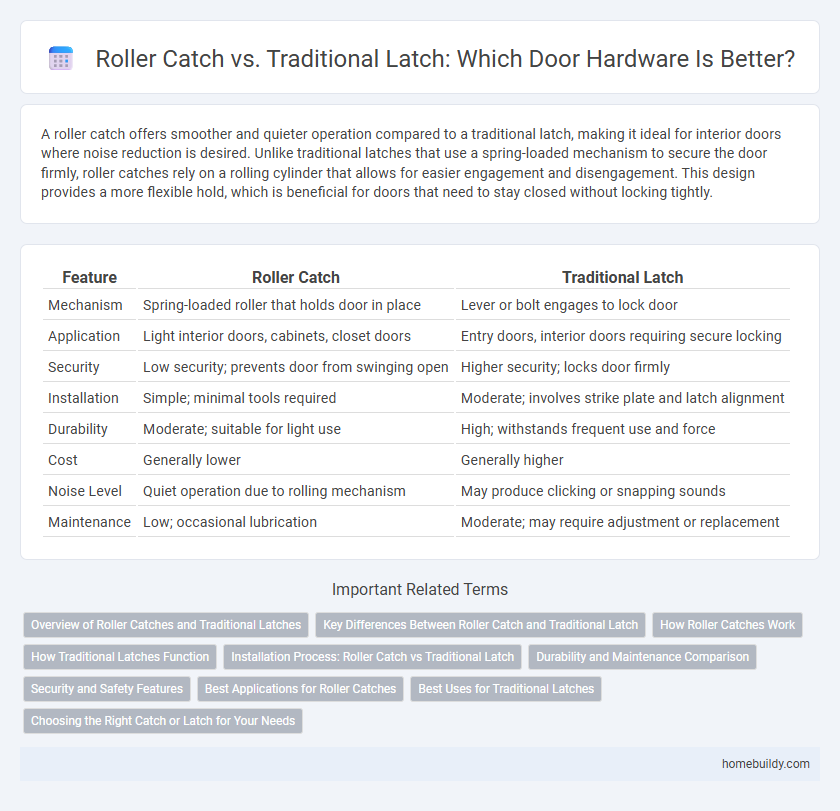A roller catch offers smoother and quieter operation compared to a traditional latch, making it ideal for interior doors where noise reduction is desired. Unlike traditional latches that use a spring-loaded mechanism to secure the door firmly, roller catches rely on a rolling cylinder that allows for easier engagement and disengagement. This design provides a more flexible hold, which is beneficial for doors that need to stay closed without locking tightly.
Table of Comparison
| Feature | Roller Catch | Traditional Latch |
|---|---|---|
| Mechanism | Spring-loaded roller that holds door in place | Lever or bolt engages to lock door |
| Application | Light interior doors, cabinets, closet doors | Entry doors, interior doors requiring secure locking |
| Security | Low security; prevents door from swinging open | Higher security; locks door firmly |
| Installation | Simple; minimal tools required | Moderate; involves strike plate and latch alignment |
| Durability | Moderate; suitable for light use | High; withstands frequent use and force |
| Cost | Generally lower | Generally higher |
| Noise Level | Quiet operation due to rolling mechanism | May produce clicking or snapping sounds |
| Maintenance | Low; occasional lubrication | Moderate; may require adjustment or replacement |
Overview of Roller Catches and Traditional Latches
Roller catches utilize spring-loaded rollers to secure doors with smooth, quiet engagement, offering enhanced resistance to jarring and vibration compared to traditional latches. Traditional latches typically employ a spring-loaded bolt or tongue that snaps into a strike plate, providing firm mechanical fastening but often producing more noise and requiring precise alignment. Roller catches are favored in cabinetry and lightweight doors for ease of use and reduced wear, while traditional latches remain common in heavy-duty applications needing robust security.
Key Differences Between Roller Catch and Traditional Latch
Roller catches use a spring-loaded roller mechanism to secure doors softly, offering quieter and smoother operation compared to traditional latches that rely on a metal bolt engaging a strike plate. Unlike traditional latches, roller catches require less force to open and close, reducing wear on door frames and hardware over time. The design of roller catches is ideal for lightweight doors or cabinets, whereas traditional latches provide a more secure lock for heavier doors needing stronger engagement.
How Roller Catches Work
Roller catches use a spring-loaded roller mechanism that engages with a strike plate to hold doors securely closed without a traditional latch bolt. The roller compresses when the door closes and snaps into place, providing smooth operation and reduced wear compared to conventional latches. This design minimizes noise and allows for easy door release with gentle pressure, enhancing both functionality and user experience.
How Traditional Latches Function
Traditional latches operate using a spring-loaded lever or bolt that fits into a strike plate to keep doors securely closed. This mechanical engagement requires precise alignment between the latch and the strike for effective locking and can sometimes cause noise or wear with repeated use. Unlike roller catches that utilize a rotating wheel to provide smooth, silent door retention, traditional latches rely on heavier components and manual force to release.
Installation Process: Roller Catch vs Traditional Latch
The installation process of a roller catch is typically more straightforward and time-efficient compared to a traditional latch, requiring fewer precise alignments and less hardware. Roller catches often involve mounting a simple spring-loaded mechanism on the door edge and a strike plate on the frame, minimizing drilling and adjustment time. Traditional latches demand more complex installation steps, including mortising the door and frame to fit the latch mechanism and strike plate accurately, which increases labor and skill requirements.
Durability and Maintenance Comparison
Roller catches offer superior durability over traditional latches due to their robust construction and fewer moving parts, reducing wear and tear. Maintenance requirements for roller catches are minimal since they do not rely on springs that can weaken or break, unlike traditional latches which often require periodic lubrication and spring replacements. The smooth operation of roller catches ensures longer lifespan and consistent performance in high-traffic areas where durability is crucial.
Security and Safety Features
Roller catches provide enhanced security and safety features compared to traditional latches by offering a smoother engagement that reduces the risk of accidental door openings. Their spring-loaded rollers ensure a firm hold, minimizing the chance of door slamming or unintended entry, which is vital in high-traffic or sensitive areas. Unlike traditional latches, roller catches maintain consistent pressure and alignment, improving durability and reliability in both residential and commercial applications.
Best Applications for Roller Catches
Roller catches provide a smoother and quieter operation compared to traditional latches, making them ideal for interior doors, cabinets, and lightweight enclosures where gentle closure is preferred. Their design allows for easy door alignment and self-adjusting functionality, which suits frequently used doors in residential and commercial settings. Roller catches excel in applications requiring minimal force to open or close, enhancing user convenience and door longevity.
Best Uses for Traditional Latches
Traditional latches excel in applications requiring secure closure and tactile feedback, such as cabinet doors and interior room doors where positive engagement is essential. Their mechanical design provides reliable holding strength, making them ideal for doors exposed to frequent use or minor impacts. Unlike roller catches, traditional latches offer better resistance to accidental openings, ensuring safety and stability in residential and commercial settings.
Choosing the Right Catch or Latch for Your Needs
Roller catches provide smooth, quiet closure ideal for lightweight doors, offering easier engagement compared to traditional latches that rely on more forceful mechanical interaction. Traditional latches are better suited for secure, heavy-duty applications where a stronger hold and resistance to accidental opening are essential. Selecting the right catch or latch depends on door weight, required security level, and desired ease of use to ensure optimal functionality and longevity.
Roller catch vs Traditional latch Infographic

 homebuildy.com
homebuildy.com